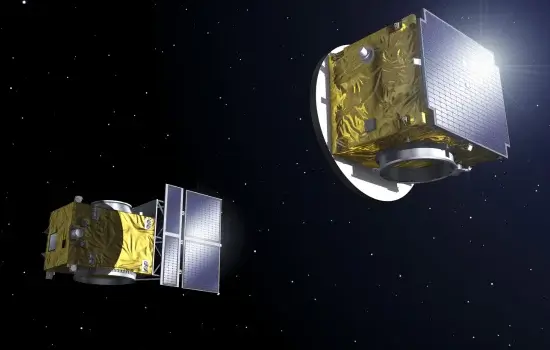On December 4, 2024, the Indian Space Research Organisation (ISRO) successfully launched the European Space Agency’s (ESA) Proba-3 mission from the Satish Dhawan Space Centre in Sriharikota, Andhra Pradesh. This mission marks a significant milestone in international collaboration for space exploration, aiming to enhance our understanding of the Sun’s corona through innovative formation-flying techniques.
Mission Overview
The Proba-3 mission comprises two satellites—Coronagraph and Occulter—that will fly in precise formation, maintaining a separation of approximately 150 meters. This configuration allows the Occulter spacecraft to block the Sun’s direct light, enabling the Coronagraph to study the Sun’s outer atmosphere, or corona, without interference. Such an arrangement effectively creates artificial solar eclipses, facilitating continuous observation of solar phenomena.
Launch Details
ISRO’s Polar Satellite Launch Vehicle (PSLV), in its 61st mission and the 26th of the PSLV-XL variant, was utilized for this launch. The rocket lifted off at 4:08 PM IST, deploying the 550 kg Proba-3 satellites into a highly elliptical orbit with an apogee of 60,530 km and a perigee of 600 km. The satellites are expected to complete an orbital period of approximately 19.7 hours.

Scientific Objectives
Proba-3’s primary goal is to demonstrate precision formation-flying technology, a critical capability for future space missions. By simulating solar eclipses on demand, the mission provides scientists with unprecedented opportunities to study the Sun’s corona, which is essential for understanding solar activity and its impact on space weather. This mission represents the world’s first precision formation-flying endeavor, showcasing advanced technological capabilities.
International Collaboration
The successful launch of Proba-3 underscores the importance of international cooperation in space exploration. ISRO’s collaboration with ESA and its commercial arm, NewSpace India Limited (NSIL), highlights India’s growing role in global space missions. Such partnerships are vital for pooling resources, expertise, and technology to achieve common scientific goals.
Future Implications
The technologies demonstrated in the Proba-3 mission have significant implications for future space endeavors. Precision formation flying can be applied to various missions, including high-resolution Earth observation, deep-space exploration, and complex scientific experiments requiring coordinated spacecraft operations. The success of Proba-3 sets a precedent for more ambitious projects involving multiple spacecraft working in unison.
Conclusion
ISRO’s successful launch of ESA’s Proba-3 mission represents a remarkable achievement in space science and international collaboration. By advancing our understanding of the Sun’s corona and demonstrating cutting-edge formation-flying technology, this mission paves the way for future innovations in space exploration. The partnership between ISRO and ESA exemplifies the collaborative spirit necessary to tackle the complex challenges of space research, promising new insights into our solar system and beyond.
Hina Abbasi is Editor and a passionate sports and entertainment content writer at WinnersMaze.com. Hina’s expertise spans across a wide range of sports, and interest in many TV shows allowing her to deliver insightful analysis and compelling stories that resonate with readers.

